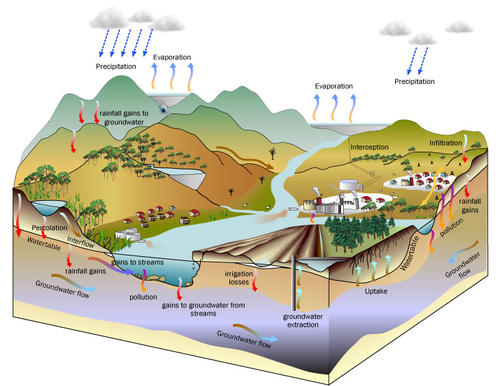Water cycle
The amount of water on earth has been constant for a very long time. Water travels the earth in a constant cycle through atmosphere, land mass and oceans. Precipitation is the main source of water for all human uses and for ecosystems with the sun as its main driver. Precipitation is taken up by plants and soils, evaporates into the atmosphere via evapotranspiration and runs off to the sea via rivers, lakes and wetlands. This water supports forests, rain-fed cultivated and grazing land as well as ecosystems. Some of the precipitation can be stored in snow and ice for centuries and temporarily some of it can also be stored in aquifers before it reappears at the earth’s surface (springs, pumps etc.). However, most water falls back into the oceans or on lands as rain, where it flows as groundwater or surface run off into rivers and the sea eventually. (WWAP 2003)
The earth is called the blue planet – more than 70 % of its surface is covered by water. (Pidwirny 2006) Although water is the most widely occurring substance on earth, only circa 2.5 % is freshwater while the remainder is salt water. Some two thirds of this freshwater are stored up in glaciers and permanent snow cover. In addition to the accessible freshwater in lakes, rivers and aquifers, man-made storage in reservoirs adds a further 8.000 cubic kilometers. Water resources are renewable (except water from ancient aquifers) with huge differences in availability in different parts of the world and wide variations in seasonal and annual precipitation in many regions. (WWAP 2003)

